BIOL 243 (BIOL 243)
Schoolcraft College
All 7 results
Sort by
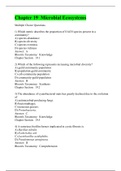
-
Chapter 19 Microbial Ecosystems,100% CORRECT
- Exam (elaborations) • 18 pages • 2021
-
- $17.49
- + learn more
Which metric describes the proportion of EACH species present in a community? A) species abundance B) species diversity C) species evenness D) species richness 2) Which of the following represents increasing microbial diversity? A) guild-community-population B) population-guild-community C) cell-community-population D) community-guild-population 3) The abundance of cyanobacterial mats has greatly declined due to the evolution of A) antimicrobial-producing fungi. B) bacteriophages...
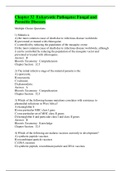
-
Chapter 32 Eukaryotic Pathogens: Fungal and Parasitic Diseases,100% CORRECT
- Exam (elaborations) • 19 pages • 2021
-
- $16.49
- + learn more
Malaria is A) the most common cause of death due to infectious disease worldwide. B) prevented or treated with chloroquine. C) controlled by reducing the population of the mosquito vector. D) the most common cause of death due to infectious disease worldwide, although it can be controlled by reducing the population of the mosquito vector and prevented or treated with chloroquine. 2) The initial infective stage of the malarial parasite is the A) sporozoite. B) merozoite. C) schizont. D...
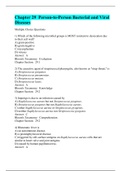
-
Chapter 29 Person-to-Person Bacterial and Viral Diseases,100% CORRECT
- Exam (elaborations) • 26 pages • 2021
-
- $16.49
- + learn more
) Which of the following microbial groups is MOST resistant to desiccation due to their cell wall? A) gram-positive B) gram-negative C) mycoplasmas D) viruses 2) The causative agent of streptococcal pharyngitis, also known as "strep throat," is A) Streptococcus pyogenes. B) Streptococcus pneumoniae. C) Streptococcus mutans. D) Streptococcus lactis. 3) Impetigo is due to an infection caused by A) Staphylococcus aureus but not Streptococcus pyogenes. B) Streptococcus pyogenes but...
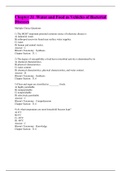
-
Chapter 31 Water and Food as Vehicles of Bacterial Diseases,100% CORRECT
- Exam (elaborations) • 15 pages • 2021
-
- $16.49
- + learn more
The MOST important potential common source of infectious disease is A) industrial waste. B) arthropod reservoirs found near surface water supplies. C) water. D) human and animal wastes. 2) The degree of susceptibility a food has to microbial activity is determined by its A) chemical characteristics. B) physical characteristics. C) water content. D) chemical characteristics, physical characteristics, and water content. 3) Flour and sugar are classified as ________ foods. A) highly ...
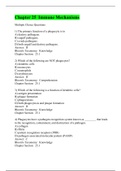
-
Chapter 25 Immune Mechanisms,100% CORRECT
- Exam (elaborations) • 23 pages • 2021
-
- $17.49
- + learn more
The primary function of a phagocyte is to A) destroy pathogens. B) engulf pathogens. C) evade pathogens. D) both engulf and destroy pathogens. 2) Which of the following are NOT phagocytes? A) dendritic cells B) monocytes C) neutrophils D) erythrocytes 3) Which of the following is a function of dendritic cells? A) antigen presentation B) plaque formation C) phagocytosis D) both phagocytosis and plaque formation 4) Phagocytes have a pathogen-recognition system known as _______...
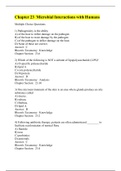
-
Chapter 23 Microbial Interactions with Humans,100% CORRECT
- Exam (elaborations) • 25 pages • 2021
-
- $18.49
- + learn more
Pathogenicity is the ability A) of the host to inflict damage on the pathogen. B) of the host to resist damage by the pathogen. C) of the pathogen to inflict damage on the host. D) None of these are correct. 2) Which of the following is NOT a subunit of lipopolysaccharide (LPS)? A) O-specific polysaccharide B) lipid A C) core polysaccharide D) M protein 3) One microenvironment of the skin is an area where glands produce an oily substance called A) mucus. B) sebum. C) fimbrae. D...
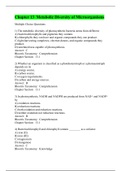
-
Chapter 13 Metabolic Diversity of Microorganisms,100% CORRECT
- Exam (elaborations) • 28 pages • 2021
-
- $17.49
- + learn more
) The metabolic diversity of photosynthetic bacteria stems from different A) bacteriochlorophylls and pigments they contain. B) chlorophylls they can have and organic compounds they can produce. C) light-harvesting complexes, electron donors, and organic compounds they produce. D) unrelated taxa capable of photosynthesis. 2) Whether an organism is classified as a photoheterotroph or a photoautotroph depends on its A) energy source. B) carbon source. C) oxygen requirements. D) carbon a...

Do you wonder why so many students wear nice clothes, have money to spare and enjoy tons of free time? Well, they sell on Stuvia! Imagine your study notes being downloaded a dozen times for $15 each. Every. Single. Day. Discover all about earning on Stuvia


